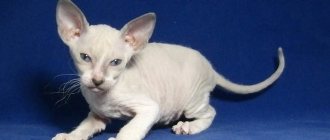The Thai cat, a description of the breed and character of which you will read below, has an unusual and long history.
A strong, slender and flexible body, blue eyes of all shades and an unusual coloring with dark ears, muzzle, paws and tail - such cats became popular in Russia in the 50-60s and were called Siamese. Many people who are far from felinology still consider such pets to be Siamese. They are unaware that the standards of the Siamese breed have changed almost beyond recognition. Only the acromelanic (color-point) color remains. However, Siamese cats of the old type, which continued to be bred by fans of the breed, thanks to the efforts of Russian breeders, also received recognition. In 1991, the new old breed was named Thai.
Brief history of the breed
Thailand, which in ancient times was called Siam, is considered the homeland of these cats. The first mention of similar animals was found in the manuscript “Book of Poems about Cats,” which dates back to the 14th-15th centuries. and is kept in the National Library of Bangkok. In those days, they lived exclusively at Buddhist temples and royal palaces. These cats not only destroyed rodents, but also allegedly protected their owners from evil spirits. Therefore, they were carefully protected.
Unusual cats came to Europe only in the second half of the 19th century. The Thai king, as a sign of his highest mercy, presented the English diplomat Owen Gould with a pair of cats of this breed as a gift. Unusual animals with interesting colors have created a real sensation in the British capital. Having learned about this, the ruler of Siam, Chulalongkorn, presented the high-ranking British with several dozen purebred individuals, with which the targeted breeding of Thais in Europe began.
By the middle of the 20th century, cats gained popularity in the United States and quickly spread throughout the world.
Interesting Facts
During the existence of the breed, many interesting things have been associated with the Thai cat:
- At the first exhibitions in Moscow and Leningrad they were exhibited under the name “Old Siamese” in the “Beginners” category.
- Thai kittens are born with snow-white fur. Dark markings begin to appear towards the end of the first month of life.
- In the Middle Ages, exporting Thai cats from Siam was punishable by death.
- Representatives of the breed were used to breed Burmese and Balinese.
- The 1991 Thai Cat Standard is currently under revision. Therefore, only those individuals whose registration documents contain the signatures of two experts are allowed for breeding.
How to breed
In Russia, especially in large cities, there are good nurseries where you can buy a kitten or find a pair for mating. But still keep in mind that you need a purebred partner, so choose him very carefully. In addition, look for animals with good health so that it is passed on to the offspring.
The first mating should take place when the cat is one year old, although she reaches puberty already at six months, sometimes earlier.
Closely monitor your cat's pregnancy and the birth of kittens.
Thai cats are wonderful mothers. They give birth quickly and feed their offspring well. Quite often they give birth to up to seven kittens.
Standards, appearance, description of the Thai cat
Thais are compact, stocky animals, similar to plump Siamese. They have strong bones and a flexible body, covered with short hair of an unusual color.
Dimensions and weight
Thais are medium-sized animals with moderate sexual dimorphism. Their weight ranges from 4-8 kg. The Thai cat looks sleeker and smaller than a cat.
Anatomical characteristics
According to the generally accepted breed standard, the Thai cat must meet the following description:
Color and coat type
Taika is a short-haired cat with a thin silky coat and poorly developed or absent down.
Representatives of the breed are characterized by the so-called Siamese color. The body of Thai cats is covered with light hair. And on the ears, paws, muzzle and tail of the animals there are contrasting marks. According to the standard, the color of Thai cats is:
On a note. With any color, the color of the nose and paw pads is in harmony with the tone of the coat. In individuals with red point colors they are pink. In a seal point Thai cat, these parts of the body are dark brown.
Possible breed defects
Flaws in appearance, in the presence of which a Thai cat will not receive a high expert assessment:
Character and temperament
Thai cats are curious and spontaneous animals that remain playful until the end of their lives. They quickly get used to people and do not like to be left alone. Thais are born actors, capable of constantly surprising and amusing their owners. Restless and funny representatives of the breed love to be the center of attention and enjoy exploring new territories.
The peaceful nature of the Thai cat makes it a real favorite of children. The delicate animal will never let out its claws and will not bite a naughty child.
Although the Thai cat prefers to spend time in the company of people, he gets along without problems with his relatives and good-natured dogs. He does not tolerate jealousy and fighting, which means he will not conflict with other pets, conquer territory or compete for his master’s attention.
Advantages and disadvantages
Like any breed, Thais have their own pros and cons. The advantages of these cats include:
- sociability;
- excellent communication skills with people and other animals;
- devotion;
- friendliness and lack of aggression;
- developed mind;
- good manners and ability to train.
But there are several disadvantages. These include an increased sense of revenge - a Thai cat will not tolerate bad treatment at all. These animals can also be called overly stubborn. If a kitten wants something, he will make every effort to achieve it.
How to choose the right kitten
The Thai breed is not rare or exotic. Therefore, problems with finding a kitten usually do not arise. In order not to become a victim of deception and not to buy a mixed breed, it is advisable to purchase an animal from a certified nursery or from a trusted breeder. At the time of the transaction, the Thai kitten must have a veterinary passport with vaccination marks and a document confirming its breed.
It is also important to pay attention to the behavior and living conditions of the animals. Thai kittens should be active, cheerful and neat. They should not have squints, kinks on the tail, white spots on the points, scratches on the skin and bald spots on the coat. The health of little Thais can be judged by the absence of bad breath, dirt under the tail, bloating, and purulent discharge from the eyes and ears.
Kitten care
Responsible breeders donate Thai kittens to new homes no earlier than they are 12 weeks old. By this age, babies are already accustomed to the tray, know how to use a scratching post and eat many foods with appetite. Therefore, new owners just have to wait until the furry pet gets used to the changed conditions and show him where his bowls, bed and toilet are located.
To prevent the little researcher from becoming a victim of an accident, household chemicals, small objects, indoor plants and wires are removed from him. Also, for safety reasons, the Thai kitten is denied free access to open ovens, washing machines and windows.
How to stay healthy
Pets of the Thai breed have good immunity, but this does not mean that they should refuse vaccinations. The health of these pets needs to be monitored like the health of any cat.
Cats may be susceptible to diseases of the liver, kidneys, and gastrointestinal tract. Although their genetics are good, there are a number of diseases that they are prone to. These are hydrocephalus, diabetes mellitus, heart disease, and breast tumors.
Cats are also susceptible to dental disease. For prevention, it is recommended to regularly brush your teeth. With proper care of your pet, the risk of disease is reduced.
Care and maintenance
Thai cats have an acromelanic coloration that darkens in the cold. Therefore, their content has some features. In the room where Thai cats live, it is necessary to maintain the air temperature at 23-25 °C. Otherwise, caring for representatives of the breed comes down to basic hygiene and proper feeding.
Hygiene procedures
In order for Thai cats to look neat, they are provided with appropriate care:
Grooming
A Thai cat does not require as much care as a long-haired cat. To make the fur of a representative of the breed look neat, it is combed 2-3 times a week with a brush with natural soft bristles or a special glove. During the molting period, the procedure is carried out more often to speed up the process of coat change.
The Thai cat is bathed 3-4 times a year using special shampoos. During bathing procedures, it is important to ensure that water does not get into the animal’s ears. And after washing the Thai, they wipe it dry with a terry towel.
Tray
The Thai cat is characterized by increased cleanliness. To make it convenient for her to relieve herself, they buy a spacious and deep tray. There are no special requirements for the filler. The main thing is that it fulfills its functions and the cat likes it.
Breeding and organization of nursery
Thai cats mature very early - by six months many are ready for mating. But the most optimal time to carry it out is a year and a half.
Mating
When selecting a partner for mating, the following rules must be observed:
- a cat and a female cat must match each other's blood type. The female of group A is mated with males A and B, males B with females A and B, females B with males B, males A with females A;
- It is better for novice breeders to buy a cat: if it has a defect, it can be corrected by a cat;
- It is advisable to choose a partner for a Thai cat of the same color. Crossing with other breeds is prohibited;
- animals must be vaccinated, dewormed and checked by a veterinarian;
- It is imperative to check the divorce mark from the exhibition, received no more than a year ago (for males - “excellent” in the open category, for females - at least “very good” in the junior or open category), or a title certificate of any date;
- the whole process must take place on the territory of the groom;
- for the time that the cat lives with the cat’s owners, you need to transport there all the necessary things (food, bed, tray and bowls);
- mating is carried out on the 2nd–3rd day of estrus and must be confirmed by a contract.
If your pet is knitting for the first time, it is better to find an experienced partner.
Pregnancy
You can determine whether a cat is pregnant by the third week after mating by a number of signs:
- swollen, bright pink nipples;
- changes in preferences, behavior and habits;
- vomiting in the morning;
- enlargement of the abdomen.
At earlier stages, pregnancy can only be determined using ultrasound. But it is recommended to resort to it in extreme cases, since there is a risk of harming the cat and kittens.
Thai cats are reverent mothers, ready to protect their kittens at any cost.
Note to the breeder
A person who decides to open a Thai cattery must have a very good understanding of the breed:
- Each nursery is registered with the club and operates according to the rules of the felinological organization to which it belongs. Therefore, first read the rules of several organizations and choose the best one for yourself;
- registration is confirmed by a document. The club seal can also be officially issued;
- Taking felinological courses will greatly help you in your activities as a breeder. The diploma will allow you to register litters and evaluate cats yourself. Each member of the club must be noted in its documentation;
- All litters are subject to activation. The kitten is assigned a metric, which can be changed to a pedigree if desired, and a certificate with a four-digit number, which is entered in the stud book;
- cats need enough space. If you are planning to open a nursery as a long-term business, then it would be a good idea to build a separate room for it.
The nursery must have a separate room equipped with everything necessary
Feeding the cat
In order for a Thai cat to develop properly and stay healthy longer, she needs a balanced diet.
Complete diet
When feeding dry food, a Thai cat is given premium or super premium class products - it contains all the necessary substances. It is important that its composition does not contain soy, dyes, preservatives and other dubious components. Thai cats eat well the following brands of food:
- Hills;
- Farmina;
- Pronature;
- Brit Care.
With a natural type of nutrition, representatives of the breed are selected a diet that contains 70-80% meat. Thai cats are also given:
- porridge with water;
- offal;
- boiled eggs;
- vegetables;
- sour milk;
- sea fish.
Pork, potatoes, beans, sweets, baked goods and sausages are permanently excluded from the menu of Thai cats. Also, the animal is not given river fish, bones, fresh milk, exotic fruits or any food from the owner’s table.
Feeding frequency
Thai kittens eat less, but more often than adult representatives of the breed. Therefore, when drawing up a feeding schedule, be sure to take into account the age of the pet:
- up to 12 weeks – 5-6 times a day;
- 3-6 months – 4 times a day;
- 6-12 months – 3 times a day.
One-year-old cats of the Thai breed are transferred to double feeding.
Vitamins and minerals
In the body of a Thai cat that eats natural food, a lack of microelements may occur. To make up for this deficiency, a representative of the breed is given special feeding courses twice a year. When choosing a supplement, they are guided by the advice of a veterinarian and the characteristics of a particular Thai.
Important. Thai cats that eat high-quality dry food do not need vitamin-mineral supplements.
Health and illness
The genes of the Thai cat contain strong immunity, so they rarely get sick, often living up to 18–20 years. But this breed also has typical diseases.
Breast tumor
The tumor can be benign or malignant. It usually affects cats over seven years of age; “young” cats are very rarely affected.
Symptoms of breast cancer include:
- thinness that appears in later stages, decreased activity, lack of appetite;
- signs of inflammation in the mammary glands, increase in size;
- the appearance of ulcers that periodically break out;
- pain when touching the glands.
If the tumor is benign, it can simply be removed through surgery. Malignant neoplasms in the initial stages are treated in the same way, but with chemotherapy. At stages 3 and 4, surgery is practically useless.
Thai cats are long-lived, often living up to 20 years
Hydrocephalus
Hydrocephalus, or dropsy of the brain, is a congenital disease that can be caused by heredity, birth trauma, or intrauterine infection. It can be detected after birth. Symptoms include:
- increased head size;
- reduced body size;
- neurological seizures starting at 8–12 weeks.
It is impossible to completely cure hydrocephalus, but competent therapy in the early stages can make a cat’s life easier.
Felinologists have found that the Thai cat scores on average 9 out of 10 points on the cat intelligence scale
Lungs' cancer
Lung cancer can affect a cat at any age. Its symptoms:
- in the early stages, frequent and dry cough;
- a little later - with sputum, pus and blood;
- severe shortness of breath, not in any way related to activity (the cat convulsively gasps for air, wheezes).
Surgery for lung cancer is most successful at stages 1 and 2, then chemotherapy is prescribed. The advanced disease is fatal and cannot be treated.
Cat cough can be caused not only by cancer, but also by asthma, heart failure, and helminthiasis.
Diabetes
In cats, diabetes is divided into two types:
- The first is extremely rare and involves the complete death of beta cells.
- The second type is characterized by a decrease in their amount necessary for the production of insulin.
Symptoms of the disease include:
- frequent urination;
- strong thirst;
- increased appetite while losing weight.
The risk group includes males, individuals who are obese and have passed the five-year mark. Diabetes is diagnosed if there is an increased and stable level of glucose in the cat’s blood and urine. For an accurate diagnosis, sometimes you need to take tests up to 5 times a day.
Diabetes in cats can be treated and alleviated. For this purpose, a special diet is developed, hypoglycemic drugs and insulin injections are prescribed. Obese cats benefit from weight loss. You should also stop taking all medications except those prescribed by your veterinarian.
The Thai cat is a classic breed, so it has very good immunity
Heart disease
Heart defects can be of two types:
- Innate. It is extremely rare and occurs most often due to the following pathologies:
- heart valves - in this case they simply do not close and push blood during contraction into the aorta, as a result of which the heart can simply stop;
- Botal duct - the prognosis depends on the size of the hole between the chambers of the heart: the smaller it is, the more chances the cat has to survive and lead a full life.
- Acquired. As a rule, this is cardiomyopathy - a pathology associated with an increase in the size of the heart, rhythm disturbances and the subsequent development of heart failure.
Serious defects are operated on extremely rarely, and uncomplicated defects will not interfere with the life of the animal
Cardiomyopathy
There are four types of this disease:
- Hypertrophic. The most common and is characterized by thickening of the walls of the heart, which causes it to work worse and is not supplied with oxygen.
- Dilatational. At the same time, the volume of the organ increases, but the walls remain the same thickness. The condition of the heart is very similar to a rag, because of this oxygen starvation occurs.
- Restrictive. The heart ceases to be elastic, as a result of which the body lacks oxygen. Cats rarely live longer than two years with this type of cardiomyopathy.
- Intermediate. Combines symptoms of several types of cardiomyopathy. This is the most dangerous and severe form of the disease.
Symptoms can be detected in the early stages by a veterinarian:
- galloping heart rhythm;
- arrhythmia;
- pulse pathology;
- heart murmurs;
- hypertension.
Cardiomyopathy is often observed against the background of other diseases: acromegaly, bull's heart, lymphoma. It may occur due to bad heredity. In this case, by curing the underlying disease, cardiomyopathy can be significantly alleviated and even eliminated.
Given the complex pathogenesis of cardiomyopathy, treatment should always be prescribed by a professional veterinarian
Education and physical activity
Thai cats are endowed with extraordinary intelligence. Highly intelligent animals perfectly understand human speech and quickly understand what is required of them. Thais are easy to train and are able to follow simple commands.
On a note. An important characteristic of Thais is their innate stubbornness. They try by any means to achieve what they want. What will help you cope with this character trait of a Thai cat is not physical strength, but limitless patience.
Thais are energetic animals, unable to sit still for long. So that they don’t get bored, they get several toys and set up a special corner with different ladders and multi-level platforms.
Horoscope compatibility
Zooastrologers identify several signs that will become true friends and companions with Thai cats.
Aries are energetic, impulsive and often stubborn. Therefore, a Thai cat, whose energy is in full swing and is ready to play constantly, will get along well with Aries and will not let him get bored.
Thais are sociable, do not like loneliness, and often show independence. Because of these character traits, they will be excellent companions for Leos.
Scorpios are passionate, passionate, willful, and have a good understanding of people. A Thai cat suits them like no other.
The breed will make friends with people born under the sign of Sagittarius. Thais are just as active and friendly.
Vaccinations and antiparasitic treatment
To prevent a Thai cat from contracting viral or infectious diseases, it is regularly vaccinated. The complex drug activates the development of stable immunity to calcivirosis, panleukopenia and rhinotracheitis. The first vaccination is given to the animal at the age of 7-8 weeks. After 21-28 days, the Thai is vaccinated against the same diseases and against rabies. In the future, a cat of this breed is vaccinated once a year.
To prevent diseases transmitted by worms and fleas, the Thai is periodically subjected to antiparasitic treatment. Anthelmintic drugs are given to a cat of this breed twice a year with mandatory repetition after 10-14 days. Thais are protected from fleas with drops, shampoos and collars.
Sterilization and castration
If a Thai cat does not have breeding value, it is recommended to sterilize it. It is advisable to carry out the operation no earlier than 7-9 months, but before the first mating. It will help prevent the development of serious diseases of the genitourinary system and will avoid the appearance of behavioral problems associated with the instinct of procreation.











